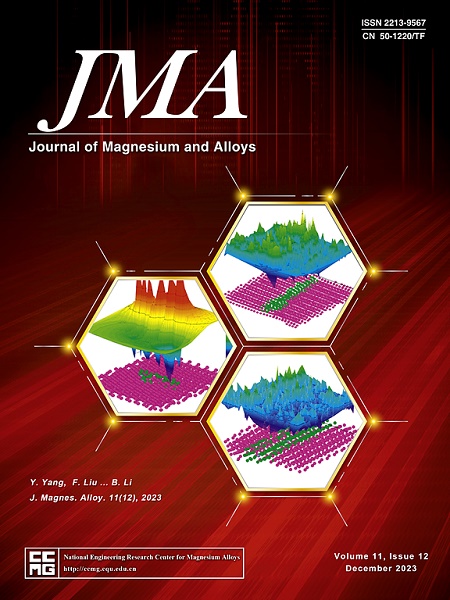A review of anticorrosive, superhydrophobic and self-healing properties of coating-composites as corrosion barriers on magnesium alloys: Recent advances, challenges and future directions
IF 13.8
1区 材料科学
Q1 METALLURGY & METALLURGICAL ENGINEERING
引用次数: 0
Abstract
Magnesium and its alloys have gained relevance for their light-weight combined with a high value of strength-to-weight ratio, which makes them useful in fields such as aerospace, automotive as well as biomedical engineering. Unfortunately, the poor corrosion resistance of Mg-alloys limits their wide acceptance. Advanced composite coatings which are self-healing, superhydrophobic anti corrosive, and wear resistant are new synthetic materials for abating these challenges. The superimposed superhydrophobic surfaces help in minimizing their water contact, thus slowing down the electrochemical reactions on the surface of the alloys, while their self-healing characteristics autonomously aid in the repair of any induced micro-crack, defect or damage towards ensuring the metal’s long-term protection. In addition, the integration of wear-resistant materials further improves the durability of coatings under mechanical stress. The most recent research efforts have been directed towards the preparation of multifunctional composites, with an emphasis on nanomaterials, functional polymers, and state-of-the-art fabrication techniques in order to take advantage of their synergistic effects. Some of the methods that have so far exhibited promising potentials in fabricating these materials include the sol-gel method, layer-by-layer assembly, and plasma treatments. However, most of the fabricated products are still faced with significant challenges ranging from long-term stability to homogeneous adhesion of the coatings and their scalability for industrial applications. This review discusses the recent progress and the relationship between corrosion inhibition and self-healing efficiencies of wear resistant polymer nanocomposite coatings. Some challenges related to optimizing coating performance were also discussed. In addition, future directions ranging from the consideration of bioinspired designs, novel hybrid nanocomposite materials, and environmentally sustainable solutions integrated with smart protective coatings were also proposed as new wave technologies that can potentially revolutionize the corrosion protection offered by Mg alloys while opening up prospects for improved performance and sustainability.


涂层复合材料作为镁合金防腐蚀屏障的防腐、超疏水和自愈性能研究进展、挑战和未来发展方向
镁及其合金因其轻量化和高强度重量比而获得了广泛应用,这使得它们在航空航天、汽车和生物医学工程等领域都很有用。不幸的是,镁合金的耐腐蚀性差限制了它们的广泛应用。自愈、超疏水、耐腐蚀、耐磨的先进复合涂料是一种新型的合成材料,可以缓解这些挑战。叠加的超疏水表面有助于最大限度地减少与水的接触,从而减缓合金表面的电化学反应,同时它们的自修复特性自主地帮助修复任何诱发的微裂纹、缺陷或损伤,以确保金属的长期保护。此外,耐磨材料的集成进一步提高了涂层在机械应力下的耐久性。最近的研究工作都是针对多功能复合材料的制备,重点是纳米材料、功能聚合物和最先进的制造技术,以利用它们的协同效应。到目前为止,在制造这些材料方面显示出有前景的一些方法包括溶胶-凝胶法、逐层组装和等离子体处理。然而,大多数制造的产品仍然面临着重大的挑战,从长期稳定性到涂层的均匀附着力以及它们在工业应用中的可扩展性。本文综述了耐磨损聚合物纳米复合涂层的研究进展及其缓蚀性能与自愈性能之间的关系。讨论了优化涂层性能所面临的挑战。此外,未来的发展方向包括考虑生物启发设计、新型混合纳米复合材料以及与智能防护涂层相结合的环境可持续解决方案,这些新技术可能会彻底改变镁合金的防腐性能,同时为提高性能和可持续性开辟前景。
本文章由计算机程序翻译,如有差异,请以英文原文为准。
求助全文
约1分钟内获得全文
求助全文
来源期刊

Journal of Magnesium and Alloys
Engineering-Mechanics of Materials
CiteScore
20.20
自引率
14.80%
发文量
52
审稿时长
59 days
期刊介绍:
The Journal of Magnesium and Alloys serves as a global platform for both theoretical and experimental studies in magnesium science and engineering. It welcomes submissions investigating various scientific and engineering factors impacting the metallurgy, processing, microstructure, properties, and applications of magnesium and alloys. The journal covers all aspects of magnesium and alloy research, including raw materials, alloy casting, extrusion and deformation, corrosion and surface treatment, joining and machining, simulation and modeling, microstructure evolution and mechanical properties, new alloy development, magnesium-based composites, bio-materials and energy materials, applications, and recycling.
 求助内容:
求助内容: 应助结果提醒方式:
应助结果提醒方式:


